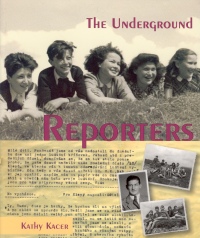| ________________
CM . . .
. Volume XI Number 8 . . . . December 10, 2004
excerpt: So, people, down with sadness! Hope keeps people alive, spiritually and often physically. Hope leads people to feign normalcy, to maintain attitudes and habits in spite of what might be overwhelming circumstances. Even prisoners of concentration camps in World War II had hope. They set up secret schools to teach their children reading, writing, art, languages, and music. Keeping hope alive was also an act of defiance in the face of the most horrible nightmare of the 20th century. Such was the case with a small group of Jewish children in the town of Budejovice, Czechoslovakia in 1940. Forbidden by the Nazi occupiers to attend school, they were further restricted from the parks and public swimming pool. The children found a swimming hole on the Vlatava River where they established their own community centre in an old shack. There, they could be ordinary children again, even if it were only a few hours a day. While lying on the riverbank, one teen, Ruda Stadler, came up with a way to keep their minds growing, to provide an opportunity for their creative abilities and to keep their spirits up even as the Nazis removed more and more of their rights. The children wrote Klepy (Czech for 'gossip'), a newspaper produced in secret, full of poetry, paintings and drawings, editorials and humour. Only one copy of each issue was typed up and distributed from person to person throughout the town. Twenty-two issues of this secret paper were published, until it became impossible for people to gather together or to transfer it from one household to the next. What began as an activity for children grew to be a lifeline for adults who also held on to hope that the future would only be brighter. Unfortunately, the Jews of Budejovice finally were deported to Theresienstadt concentration camp, and, by the end of the war, most of them had perished, including Ruda. But Klepy was kept hidden, thanks to a former housekeeper for Ruda's family. One survivor, John Freund, made his way to Toronto where he built a new life. It was there, decades later, that author Kathy Kacer learned of this powerful story and began the task of recording it for history. The Underground Reporters documents a period in history that should never be forgotten. Part of "The Holocaust Remembrance Series for Young Readers," it tells the story of young children in a poignant, tangible style that will keep readers turning pages, hoping against hope that the ending will be happy. Sprinkled with the optimistic drawings, photographs and writings, the samples from Klepy show off the talent, inventiveness, and sense of fun of the contributors. The reconstructed conversations are based on interviews with Freund and others involved in the illicit newspaper. They create a plausible image both of daily life and the desperate situation people were in.
Kacer writes about and speaks publicly to young children about the Holocaust. Her previous books include Clara's War and The Secret of Gabi's Dresser. The Underground Reporters is clearly written and is well designed to be used as an educational tool for children. It can serve as a read-alone, or it can be used by parents or teachers who are looking for ways to teach about racism, anti-Semitism and World War II. It joins the many valuable contributions to the body of literature for children on this topic. The Underground Reporters can also be an inspiration for children about how the human spirit can triumph over adversity. Highly Recommended. Harriet Zaidman is a teacher-librarian in Winnipeg, MB.
To comment
on this title or this review, send mail to cm@umanitoba.ca.
Copyright © the Manitoba Library Association. Reproduction for personal
use is permitted only if this copyright notice is maintained. Any
other reproduction is prohibited without permission.
NEXT REVIEW |TABLE OF CONTENTS FOR THIS ISSUE
- December 10, 2004.
AUTHORS
| TITLES | MEDIA REVIEWS
| PROFILES
| BACK ISSUES
| SEARCH | CMARCHIVE
| HOME |
